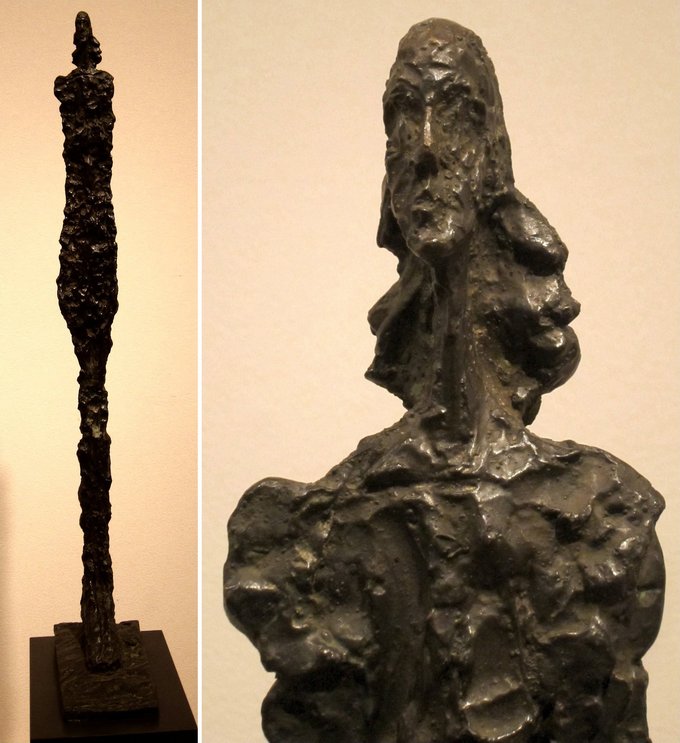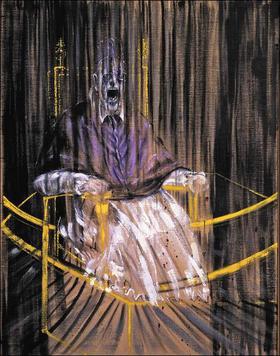In the 1950s the Center of the Western Art World Shifted From Paris to
Contemporary Art
Contemporary fine art is the overall production of art made later Globe State of war Ii.
Learning Objectives
Differentiate betwixt the categories of late modernism and post modernism in fine art.
Key Takeaways
Central Points
- The predominant term for fine art produced since the 1950s is Contemporary Fine art. The terminology often points to similarities between late modernism and post-modernism, although at that place are differences.
- Modern art, radical movements in Modernism, and radical trends regarded as influential and potentially equally precursors to late modernism and postmodernism emerged around Earth War I and specially in its backwash.
- The discourse that encompasses the two terms Tardily Modernism and Postmodern art is used to announce what may be considered as the ultimate phase of modern art, as art at the end of modernism or as certain tendencies of contemporary fine art.
- Tardily modernism describes movements which ascend from and react against trends in modernism and rejects some aspect of modernism, while fully developing the conceptual potentiality of the modernist enterprise.
Fundamental Terms
- Cubism: An early-20th-century avant-garde art movement pioneered past Pablo Picasso and Georges Braque, where objects are analyzed, cleaved upwardly and reassembled in an abstracted form.
- precursors: That which precedes; a precursor; a predecessor; an indicator of approaching events.
- Surrealism: An artistic movement and an aesthetic philosophy, pre-dating abstract expressionism, that aims for the liberation of the listen by emphasizing the critical and imaginative powers of the subconscious.
Groundwork
The predominant term for art produced since the 1950s is Contemporary Art. Not all art labeled 'contemporary' is modern or postmodern, and the term contemporary encompasses both artists who continue to work in modernist or late modernist traditions, as well equally artists who pass up modernism for postal service-modernism or other reasons. Arthur Danto argues explicitly in After the Finish of Fine art that contemporaneity is the hypernym, and that postmodern objects correspond a sub-sector of the contemporary motility which replaced modernity and modernism.
Radical movements in modern art
Modern art, radical movements in Modernism, and radical trends regarded as influential and potential precursors to late modernism and postmodernism emerged around World State of war I and particularly in its aftermath. With the introduction of the use of industrial artifacts in art came movements such equally Cubism, Dada, and Surrealism besides as techniques such as collage and art forms such as cinema and the rising of reproduction every bit a means of creating artworks. Pablo Picasso, Marcel Duchamp, and many others created important and influential works from found objects.

Pablo Picasso, Les Demoiselles d'Avignon, 1907: This work past Picasso is considered to be a major step towards the founding of the Cubist motility.
Late Modernism vs. Postmodernism
The discourse surrounding the terms Late Modernism and Postmodern art is fraught with many differing opinions. There are those who argue against whatsoever partition into modern and postmodern periods. Some don't believe that the period called modernism is over or even nigh the terminate, and there certainly is no agreement that all art after modernism is post-modernistic, nor that postmodern art is universally separated from modernism; many critics see information technology every bit merely another stage in mod art or another form of tardily Modernism. In that location is, still, a consensus that a profound change in the perception of works of fine art, and works of fine art themselves, has occurred and that a new era has been emerging on the earth stage since at to the lowest degree the 1960s.
Belatedly modernism describes movements which arose from and react against trends in modernism, rejecting some aspect of modernism, while fully developing the conceptual potentiality of the modernist enterprise. In some descriptions post-modernism as a period in art history is completed, whereas in others it is a continuing movement in Contemporary fine art. In art, the specific traits of modernism which are cited more often than not consist of: formal purity, medium specificity, art for art'southward sake, the possibility of actuality in fine art, the importance or even possibility of universal truth in art, and the importance of an avant-garde and originality. This concluding bespeak is 1 of detail controversy in art, where many institutions contend that being visionary, forward-looking, cutting border, and progressive are crucial to the mission of art in the nowadays, and that postmodern art therefore represents a contradiction of the value of art of our times.
1 compact definition of postmodernism is that it rejects modernism's grand narratives of artistic management, eradicates the boundaries between loftier and low forms of art, disrupts the genre and its conventions with collision, collage, pastiche, and fragmentation. Postmodern art comes from the viewpoint that all stances are unstable and insincere, and therefore irony, parody, and humor are the only positions which cannot be overturned by critique or later events.
European Postwar Expressionism
Postwar European artists, unlike American abstruse expressionists, grappled with the isolated experience of the individual figure.
Learning Objectives
Contrast European postwar expressionism with contemporary expressionism in America
Key Takeaways
Key Points
- Following the end of WWII and the advent of American abstract expressionism, the center of western creative activity shifted from Paris to New York.
- Many European artists were heavily influenced by the intellectual movement existentialism. This involvement is reflected in their attempts to grapple with the meaning of the isolated effigy in the postwar world.
- The closest equivalents to American abstract expressionism were the French painting movements Tachisme and Fine art Informel. The artistic approach of these movements was characterized by intuitive abstraction and abandonment of premeditated structure.
Cardinal Terms
- existentialism: A twentieth-century philosophical movement emphasizing the uniqueness of each human existence in freely making cocky-defining choices. This movement had foundations in the thought of Søren Kierkegaard (1813-55) and Friedrich Nietzsche (1844-1900) and was notably represented in the works of Karl Jaspers (1883-1969), Gabriel Marcel (1887-1973), Martin Heidegger (1889-1976), and Jean-Paul Sartre (1905-lxxx).
- Surrealism: An creative movement and artful philosophy that aims for the liberation of the mind by emphasizing the critical and imaginative powers of the subconscious.
In the Postwar menstruation, the centre of modern creative activeness in the west shifted from Paris to New York. One of the biggest contributing factors to this shift was the advent of abstract expressionism, a decidedly American movement oftentimes cited as the kickoff American advanced. Visionary figures like Jackson Pollock, Mark Rothko, and Barnett Newman epitomized abstract expressionism in New York, but a like business organization for expressionism was present in the piece of work of many of import European artists in the aftermath of World War Ii.
The Postwar Figure
While both American and European artists were influenced past the postwar rhetoric of feet, alienation, and disillusionment, the American school was also heavily influenced by Surrealism and moved increasingly toward reductive abstraction and away from representing biomorphic forms as a means for pursuing the cocky-expression of the unconscious.
Unlike American Expressionism, which was more abstract, many European painters maintained the primacy of the figure in their work. More than concerned with the philosophical and cultural movement of Existentialism, European artists grappled with the significant of the figure and its isolated, private experience of the earth. Existentialist themes oft framed the work of figurative artists such every bit Francis Bacon, Lucian Freud, and Alberto Giacometti. Bacon and Freud were British painters who painted expressive portraits noted for their psychological penetration. Giacometti was a Swiss painter and sculptor mostly known for his sculptures of isolated, attenuated figures. These figures were thought to reflect the postwar view that life was void of meaning.

Alberto Giacometti, Woman of Venice VII, 1956, bronze. Fine art Gallery of New Southward Wales.: Giacometti's "Woman of Venice VII" presents the typical solitary figure often seen in his work, which was heavily influenced by existentialist thought.

Francis Bacon, Study after Velazquez's Portrait of Pope Innocent X, 1953, oil on canvas, 60 x 46 in. De Moines Art Middle, De Moines, Iowa.: This painting by Bacon exemplifies a figurative portrayal of existential and individual angst that European Expressionists typically display in their work.
Tachisme/Fine art Informel
During this period, European artists engaged more fully in abstraction, peculiarly those associated with the French painting movements Tachisme (from the French word tache, meaning stain) and Art Informel. Tachisme is often regarded every bit the closest European equivalent to American abstruse expressionism, and tin can be characterized by spontaneous brushwork, drips and blobs of pigment applied straight from a tube, and, occasionally, scribbling reminiscent of calligraphy. Of import Tachisme painters include Jean-Paul Riopelle, Jean Dubuffet, Pierre Soulages, Nicholas de Stael, Hans Hartung, Serge Poliakoff, Georges Mathieu, and Jean Messagier. Art Informel, a movement closely related to Tachisme, rejected the geometric, difficult-border mode of American abstraction in favor of a more intuitive grade of expression. "Informel" referred to the lack of grade itself and the absence of a premeditated construction.
Source: https://courses.lumenlearning.com/boundless-arthistory/chapter/the-world-since-1950-ce/#:~:text=In%20the%20Postwar%20period%2C%20the,the%20first%20American%20avant%2Dgarde.
0 Response to "In the 1950s the Center of the Western Art World Shifted From Paris to"
Post a Comment